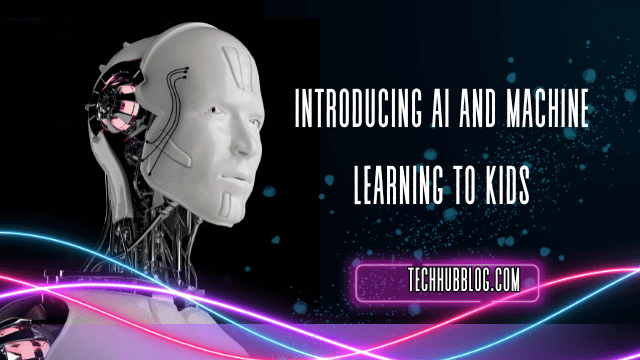Introducing AI and Machine Learning to Kids
Artificial intelligence (AI) and machine learning (ML) are entering mainstream consciousness, and it’s hard to find an industry that hasn’t been impacted by these technologies. According to Forbes, “AI is expected to see an annual growth rate of 37.3% from 2023 to 2030”.
With their growing influence, it’s becoming increasingly crucial for the next generation to understand and embrace these concepts.
If you want your child to learn about artificial intelligence and machine learning, here are ways to introduce these concepts to kids without overwhelming them.
-
Demystifying AI and ML
Before teaching kids about artificial intelligence and machine learning, it’s essential to explain these terms. Simplifying AI and ML for kids should start with the broad concepts. At its core, AI is about creating machines that can think like humans. Machine Learning, one application of AI, gives computers the ability to learn without explicitly being programmed.
-
Start with Everyday Examples
Kids might not know what AI is, but, even at a young age, they’ve probably interacted with it. Siri, Alexa, recommended videos on YouTube – all of these use some form of AI. Start by pointing out these everyday applications. When they ask YouTube to play their favorite song and it suggests another they might like. That’s machine learning in action!
-
Use Interactive Tools Designed for Kids
Several platforms offer interactive lessons on AI and ML tailored for children. Tools like ‘Machine Learning for Kids’ provide projects and tutorials that simplify complex concepts into digestible chunks. These platforms often use visual programming environments, which are perfect for beginners.
-
Hands-on Projects: The Fun Way to Learn
One of the most effective ways for kids to grasp a concept is to see it in action. Consider simple DIY projects:
Image Recognition: Use platforms like ‘Teachable Machine’ by Google, which lets kids train a model to recognize images, sounds, or poses.
Chatbots: Allow kids to use chatbots with parental supervision. Then they can design their own basic chatbots, teaching them about natural language processing.
Neural networks: Kids can test what they’ve learned in apps like Tensorflow Playground which uses a visual representation of the data, features, layers, and output.
-
Learn Coding for Kids
Learning to code is an important first step towards learning AI and ML. Coding serves as the foundational skill for crucial elements in AI and ML like developing algorithms, training models, and analyzing data. They can join coding classes for kids to learn programming languages like Python, which is commonly used for these advanced tasks. Not only will learning to code provide the technical skills needed, but it will also cultivate problem-solving abilities and logical thinking.
-
Games that Teach AI
Several games introduce AI concepts in a fun, engaging manner.
Games like ‘While True: learn()’ give players AI-based tasks, blending education with entertainment. ArtBot is a game for players of all ages which teaches the basics of Artificial Intelligence. Kids have to find and retrieve stolen art objects by training an AI helper.
-
Storytelling and Analogies
Use stories or analogies to explain concepts. We often compare a computer to a brain. This helps them understand the concept of learning for a computer, similar to the way humans learn. You could also compare training an AI model to teaching a pet. Just as dogs learn commands through repetition, machines learn patterns through data. Lead kids to ask questions by tying AI and ML to stories and concepts they are familiar with.
-
Focus on Ethics and Responsibility
With great power comes great responsibility. It’s vital to teach kids about the ethical aspects of AI. These arise from the potential AI systems have to embed biases, contribute to climate degradation, threaten human rights, and more. Discuss topics like bias in AI, where if a machine is trained only on a particular set of data, it might not recognize or understand anything outside that data. Such conversations can spark critical thinking and problem solving in kids.
-
Encourage Curiosity and Exploration
Kids are inherently curious. Provide them with resources to explore further. Websites like Outschool offer beginner courses on AI and ML. Kids as young as 6 can start to learn AI and ML concepts. While some content might be advanced, exposure can ignite passion.
-
AI and Art: An Unusual Blend
AI isn’t just about data and algorithms; it has applications in art too! Generative AI can create content including text, images, audio, and video. This cross section of art and technology means that even kids pursuing non-STEM careers can benefit from learning artificial intelligence and machine learning. Tools like DeepDream allow kids to generate artwork using AI, showcasing the technology’s creative side.
-
The Power of Community
Consider joining or forming AI and ML clubs for kids. Learning in a community of their peers can be more effective and even motivational. Platforms like AI4ALL, designed for teenagers, offer programs, camps, and communities focused on AI education.
Ultimately, teaching AI and machine learning to kids isn’t about creating prodigies but fostering awareness, understanding, and curiosity. By breaking down concepts, using interactive tools, and emphasizing hands-on learning, we can prepare the next generation for a future where AI is part and parcel of everyday life. They can start to understand how the technical world around them works and be an active participant.
Remember, the goal is not just knowledge but also ethical and responsible use of such technology. The combination of these will ensure a future where AI is used for the betterment of society.
